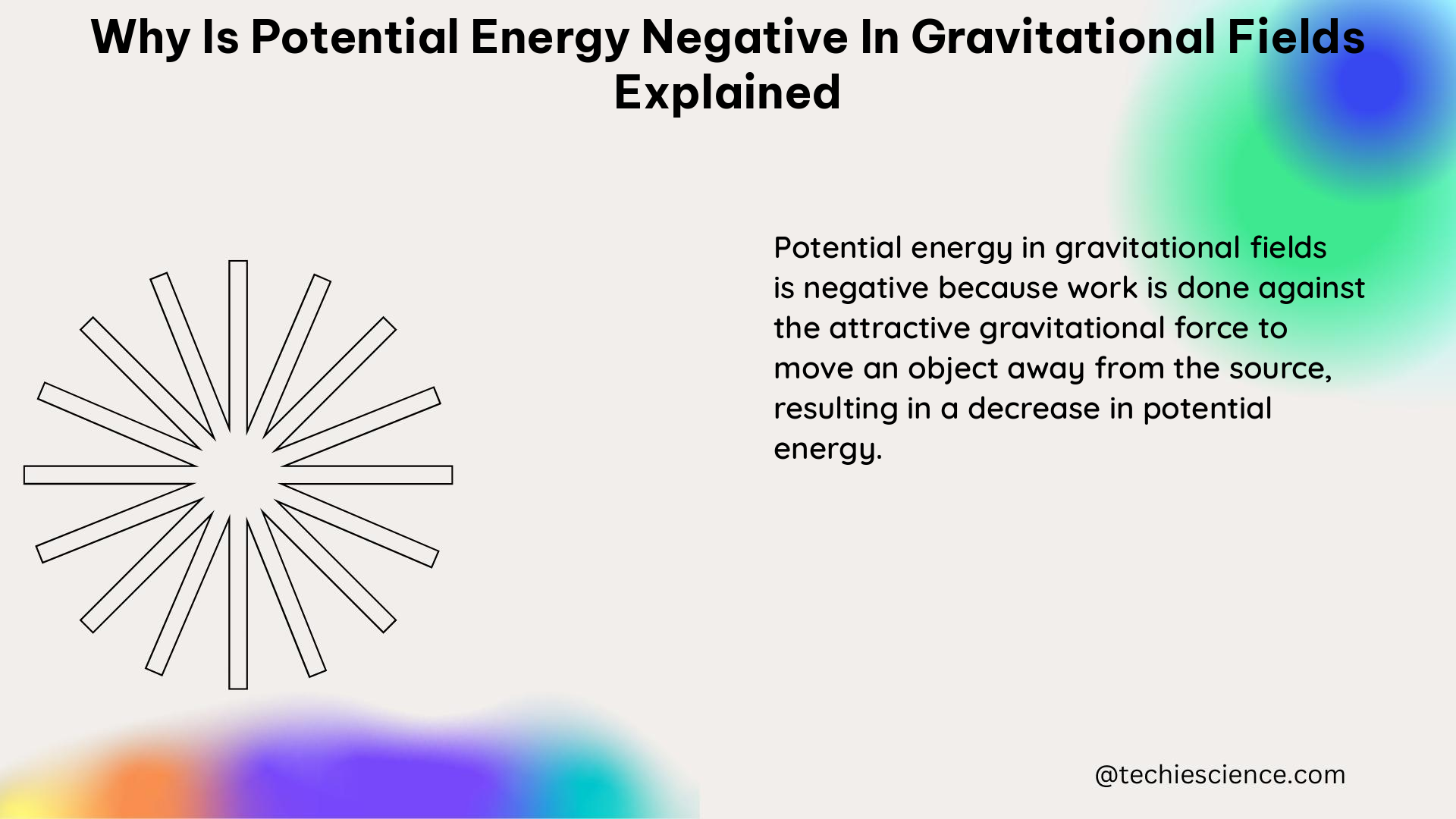The concept of negative potential energy in gravitational fields is a fundamental principle in classical mechanics and is crucial for understanding the behavior of objects in gravitational fields. This comprehensive guide will delve into the technical details and provide a thorough explanation of why gravitational potential energy is negative.
Definition of Gravitational Potential Energy
Gravitational potential energy (GPE) is defined as the work done to bring a small “test” mass from infinity to a point in a gravitational field. This energy is negative because it takes positive energy to move the mass away from the gravitational force, which wants to pull it closer.
The formula for gravitational potential energy is:
$$PE = -\frac{GMm}{r}$$
where:
– $G$ is the gravitational constant (6.674 × 10^-11 N⋅m^2/kg^2)
– $M$ is the mass of the large object (e.g., the Earth)
– $m$ is the mass of the small object
– $r$ is the distance between the centers of the two objects
Integration and Convention

The negative sign in the gravitational potential energy formula arises from the integration of the gravitational force over distance. It is mathematically convenient to define the potential energy at infinity as zero, making all other configurations negative.
This convention ensures that the total energy of a system at infinite separation is zero, which is important for understanding energy conservation and orbital mechanics. It also simplifies the calculations and allows for a consistent interpretation of the potential energy in gravitational fields.
Physical Significance
The negative sign in the gravitational potential energy formula does not have a direct physical significance but is rather a result of the chosen convention. What is important is the change in gravitational energy, which is equal to the work done by gravity.
The negative potential energy indicates that it takes energy to move objects away from each other against the attractive force of gravity. This energy is stored in the gravitational field and can be released when the objects are allowed to move closer together.
Arbitrary Zero Point
The zero point of gravitational potential energy can be chosen arbitrarily, but it is often set at infinity for convenience. This means that all other points in the gravitational field have negative potential energy.
In simple mechanics problems, the zero point can be set at the floor or surface of a table, but for large distances, it is set at infinity to make calculations more convenient and to align with the convention used in orbital mechanics and astrophysics.
Practical Applications
The negative potential energy in gravitational fields has several practical applications:
-
Orbital Mechanics: The negative potential energy helps in understanding escape velocity, orbits, and hyperbolic paths of objects in gravitational fields, such as satellites, planets, and stars.
-
Energy Conservation: The convention of setting the potential energy at infinity as zero allows for the conservation of total energy (kinetic energy + potential energy) in a gravitational system.
-
Mechanics Problems: In simple mechanics problems, the negative potential energy is used to calculate the work done by gravity and the changes in the total energy of a system.
Examples and Numerical Problems
- Example 1: Calculate the gravitational potential energy of an object with a mass of 10 kg at a height of 100 m above the surface of the Earth, assuming the Earth’s mass is approximately 5.97 × 10^24 kg and the gravitational constant is 6.674 × 10^-11 N⋅m^2/kg^2.
Solution:
$$PE = -\frac{GMm}{r} = -\frac{6.674 \times 10^{-11} \times 5.97 \times 10^{24} \times 10}{6.37 \times 10^6 + 100} \approx -5.88 \times 10^5 J$$
- Example 2: Calculate the escape velocity from the surface of the Earth, given the Earth’s mass and radius.
Solution:
$$v_e = \sqrt{\frac{2GM}{r}} = \sqrt{\frac{2 \times 6.674 \times 10^{-11} \times 5.97 \times 10^{24}}{6.37 \times 10^6}} \approx 11.18 km/s$$
Figures and Data Points
The graph of gravitational potential energy versus distance from the center of the Earth would be a negative, inverse-square curve, with the potential energy approaching zero as the distance approaches infinity.
Measurements and Values
- The gravitational constant: $G = 6.674 \times 10^{-11} N \cdot m^2 \cdot kg^{-2}$
- The mass of the Earth: $M = 5.97 \times 10^{24} kg$
- The radius of the Earth: $r = 6.37 \times 10^6 m$
References
- What is Gravitational Potential Energy? Why is it Negative?
- Why is Gravitational Potential Energy Negative?
- Why is Gravitational Potential Energy Negative?
- Why is Gravitational Potential Energy Negative and What Does That Mean?
- What is Gravitational Potential Energy?

The lambdageeks.com Core SME Team is a group of experienced subject matter experts from diverse scientific and technical fields including Physics, Chemistry, Technology,Electronics & Electrical Engineering, Automotive, Mechanical Engineering. Our team collaborates to create high-quality, well-researched articles on a wide range of science and technology topics for the lambdageeks.com website.
All Our Senior SME are having more than 7 Years of experience in the respective fields . They are either Working Industry Professionals or assocaited With different Universities. Refer Our Authors Page to get to know About our Core SMEs.